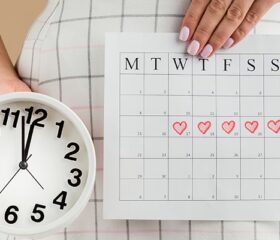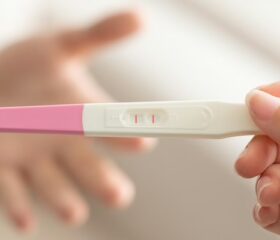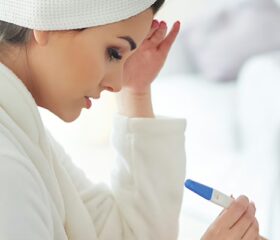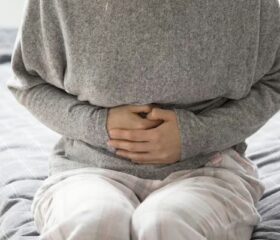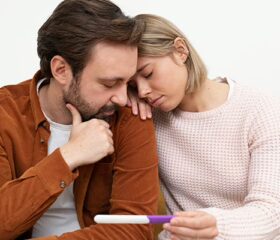What Is Ovulation? Timeline, Symptoms, Pain, and Fertility
You’ve probably heard the term “ovulation” being tossed around, regardless of whether you’re trying to conceive or just want to understand your body better.

- What is ovulation?
- What hormonal changes in your body are linked to ovulation?
- What are the signs and symptoms of ovulation?
- How can you track your ovulation to find your fertile window?
- What is irregular ovulation and what causes it?
- How can you boost your ovulation and fertility?
- How can your doctor help you with ovulatory issues?
- Final thoughts
Figuring out when you usually ovulate can be tricky, but it’s important. This natural process is a cornerstone of your fertility, and knowing the ins and outs can smooth your family planning experience.
Here’s what you need to know about ovulation, when it happens, what symptoms to expect, and how it affects your fertility.
What is ovulation?
Ovulation is the phase in your menstrual cycle when a mature egg is released from one of your ovaries (you have two of these, but most months, only one will release an egg).
The egg then travels down your fallopian tube (you also have two of these) and waits to get fertilized by sperm. It only survives for 12–24 hours, so timing sex at just the right point can maximize the chances that the sperm will reach the egg. 1 2
When does ovulation occur?
Usually, ovulation occurs about 2 weeks before your next period, midway through your monthly menstrual cycle (e.g., on day 14 of a 28-day cycle). 3
Bear in mind that a “normal” cycle may range from 21 to 35 days. The timing of ovulation varies from woman to woman and can also vary slightly from month to month, so tracking your cycle is the best way to figure out when you’re due to ovulate. 4 5
What is your fertile window?
Your fertile window consists of the 7 days in your menstrual cycle when you’re most likely to get pregnant. 6
Again, after you ovulate, your egg is viable for fertilization for 12–24 hours. Sperm can survive for up to 5 days in your reproductive tract. 7 This means you can conceive if you have sex in the 5 days leading up to ovulation, on the day of ovulation itself, or even the day after. 8
While your fertile window is about 7 days long, your best chance of conceiving happens when you have sex during the 2 days before ovulation and on the day of ovulation itself. 9
What hormonal changes in your body are linked to ovulation?
Your body undergoes many hormonal fluctuations before you actually release an egg.
First, your hypothalamus (in your brain) releases a chemical called gonadotropin-releasing hormone (GnRH). This signals to your pituitary gland (also in the brain) to secrete follicle-stimulating hormone (FSH) and luteinizing hormone (LH). 9 10
FSH, in turn, stimulates your ovarian follicles (fluid-filled sacs in the ovaries containing undeveloped eggs) to mature. Usually, one follicle becomes dominant and prepares to release a mature egg. 11
When the egg matures, it causes an LH surge that triggers your ovary to release the egg. This is the actual moment of ovulation. 10
After that point, another hormone, progesterone rises. This prepares your uterine lining for the potential implantation of a fertilized egg. If you don’t get pregnant, the lining sheds, resulting in your period.
It’s sometimes possible to ovulate without getting your period
You can ovulate without getting your period if you have scarring on your uterus or take certain hormonal medications. However, you may still experience bleeding resembling menstruation when you don’t ovulate if your uterine lining gets too thick. 12
What are the signs and symptoms of ovulation?
You may spot a few bodily changes that signal you’re about to ovulate (or are already ovulating). The most common ovulation symptoms to watch out for include: 5
- Egg white discharge
- Increased sex drive
- Tender breasts
- Light spotting
- Bloating
- Mood changes
- Heightened sense of sight, smell, or taste
Around 40% of women who ovulate also experience ovulation pain (also known as mittelschmerz). It’s a one-sided abdominal pain or cramping that usually lasts for a few hours, but can persist for up to 48 hours. 13
Remember that not everyone experiences these symptoms, and their intensity can vary. Tracking your symptoms throughout multiple cycles can help you determine what’s normal for you.
How can you track your ovulation to find your fertile window?
As mentioned, ovulation usually occurs halfway through your cycle. It sounds simple enough to track, and if you have a regular, highly predictable cycle, a simple ovulation calculator may work for you.
However, pinpointing ovulation can feel like a guessing game when you have irregular periods. 14
Here are a few methods you can combine for more accurate tracking of your ovulation: 6
- Calendar method: To figure out when that ovulatory midpoint occurs, track your cycle length for 6 months, which you can do by marking the first day of your period on a calendar or in a period tracker app. 6 Subtract 18 days from your shortest cycle and 11 days from your longest cycle. The resulting range indicates your most fertile days. 15
- Basal body temperature (BBT) tracking: It’s not an exact science, but some women notice a dip in their basal body temperature 1–2 days before ovulation and then a slight increase (0.4 to 1 °F) after. 16 17 Use a basal thermometer to measure your temperature every morning before getting out of bed and before you have anything to eat or drink. Record your temperatures over several months to identify your temperature patterns.
- Cervical mucus monitoring: Look for changes to your vaginal discharge throughout your cycle. After your period, you may notice that your discharge is quite light. As you approach ovulation, it will increase in volume and become clear, slippery, and stretchy, resembling egg whites. This consistency helps sperm travel more easily and lasts for 4 days (including the days leading up to ovulation and the day of ovulation itself). 18 19
- Ovulation predictor kits (OPKs): A positive result on your ovulation test strip indicates that there’s a surge of LH in your urine, which means you’re going to ovulate in the next 24–36 hours. 20 21 However, these tests won’t be as accurate for you if you have polycystic ovarian syndrome (PCOS), as your LH may remain consistently high or fluctuate unpredictably throughout your cycle. 22 Ask your doctor for tips on how to track ovulation with PCOS.
- Fertility monitors: These devices track multiple hormones in your urine to identify your fertile window more precisely.
Note that you don’t have to use just one method. Combining multiple methods and tools may provide more accuracy, especially if you’re trying to track ovulation with irregular periods. Using a journal or ovulation tracker can also help you aggregate your logged symptoms and get a clearer picture of your cycle.
What is irregular ovulation and what causes it?
You probably won’t ovulate regularly if you just started menstruating, are approaching menopause (which typically happens between ages 40 and 50), or are breastfeeding. 23 24
Some medical conditions can even throw off your body’s natural rhythm and cause irregular or absent ovulation (anovulation), including: 24 25
- Polycystic ovary syndrome (PCOS)
- Primary ovarian insufficiency (POI)
- Issues with your thyroid, kidneys, or liver
- Hyperprolactinemia
Other factors
Certain lifestyle factors also increase your risk of irregular ovulation or anovulation, such as: 24
- Excessive exercise
- Eating disorders
- Stress
- Being obese or underweight
- Hormonal birth control (e.g., the pill, patch, vaginal ring, and implants) 26
See your doctor if you’re having difficulty tracking your ovulation or if you believe you’re not ovulating regularly. If you’re trying to conceive, schedule a preconception appointment with your doctor or see a fertility specialist. They can perform tests to determine the cause of your fertility issues and recommend appropriate treatment.
How can you boost your ovulation and fertility?
Again, if you suspect that you’re not ovulating regularly, you should see your doctor, especially if you believe that an undiagnosed medical condition is to blame.
However, if you think your lifestyle habits (diet, exercise, weight, stress, etc.) are the major contributing factors affecting your fertility, there are steps you can take to address these issues:
- Eat a nutritious diet: If you’re trying to conceive, try to maintain a healthy weight through a balanced diet of fruits, vegetables, beans, lean protein, whole grains, and lower-mercury fish (e.g., salmon, scallops, and shrimp). Limit fried foods, processed foods, and sugary drinks and baked goods. 27 28 Don’t forget to ask your doctor for other recommendations on what to eat to get pregnant faster.
- Exercise moderately: It goes without saying that exercise is good for you, but as mentioned, overdoing it can sometimes interfere with ovulation. 24 In your pre-pregnancy workout plan, stick to moderate exercises recommended by your doctor.
- Manage stress: Chronic stress can disrupt our hormone balance, which inhibits ovulation. 29 Practice relaxation techniques like yoga, meditation, or deep breathing exercises. 24
- Take supplements: Some supplements, like folic acid, vitamin B12, and omega-3 fatty acids, may support your fertility. 28 Talk to your doctor before taking any new supplements.
- Quit unhealthy habits: Drinking alcohol excessively, using cocaine or marijuana (or other recreational drugs), and smoking while trying to conceive can all negatively impact your fertility. 30 31
Consult a fertility specialist if you’ve been trying to conceive for a year (or 6 months if you’re over 35) without success. 32 They’ll be able to better evaluate you and outline the next steps.
How can your doctor help you with ovulatory issues?
Don’t be discouraged if lifestyle changes aren’t enough or if you’re struggling with a medical condition that affects your fertility. It’s still possible to get pregnant with PCOS and other conditions.
Your doctor may give you oral medications like clomiphene citrate and letrozole or injectable hormones like gonadotropins to stimulate your ovaries and cause ovulation.
If you need to undergo more treatment with assisted reproductive technology (ART) like IVF or IUI, your doctor may give you these medications beforehand to jumpstart the process if you have ovulatory challenges. 33
Final thoughts
Understanding ovulation is one of the first steps to take charge of your fertility. Track your cycle, learn the signs of ovulation, and make healthy lifestyle choices so you can optimize your chances of conceiving.
If you have any concerns about your ovulation or fertility, don’t hesitate to reach out to your doctor for personalized guidance and support.
Article Sources
- Intermountain Health. "Ovulation Made Simple: A Four Phase Review" Retrieved October 21, 2025.
- NewYork-Presbyterian. "Cycle Syncing: How to Understand Your Menstrual Cycle to Reduce Period Symptoms" Retrieved October 21, 2025.
- University of Rochester Medical Center. "Ovulation Date Calculator" Retrieved October 21, 2025.
- Cleveland Clinic. "Menstrual Cycle" Retrieved October 21, 2025.
- University of Utah Health. "Ovulation: When Is the Best Time to Get Pregnant?" Retrieved October 21, 2025.
- Johns Hopkins Medicine. "Calculating Your Monthly Fertility Window" Retrieved October 21, 2025.
- UCSF Center for Reproductive Health. "Conception: How It Works" Retrieved October 21, 2025.
- American College of Obstetricians & Gynecologists. "Fertility Awareness-Based Methods of Family Planning" Retrieved October 21, 2025.
- Vinmec Healthcare System. "Can You Get Pregnant If You Have Sex 7 Days Before or After Your Period?" Retrieved October 21, 2025.
- Eunice Kennedy Shriver National Institute of Child Health and Human Development. "6 Things to Know about Ovulation" Retrieved October 21, 2025.
- StatPearls. "Physiology, Ovulation" Retrieved October 21, 2025.
- Vinmec Healthcare System. "Do ovulation occur without menstruation?" Retrieved October 21, 2025.
- Cleveland Clinic. "Ovulation Pain" Retrieved October 21, 2025.
- Cleveland Clinic. "Rhythm Method" Retrieved October 21, 2025.
- ColumbiaDoctors. "Basal Body Temperature (BBT) Tracking" Retrieved October 21, 2025.
- Cleveland Clinic. "Basal Body Temperature " Retrieved October 21, 2025.
- Planned Parenthood. "What's the cervical mucus method of FAMs?" Retrieved October 21, 2025.
- Cleveland Clinic. "Cervical Mucus" Retrieved October 21, 2025.
- Women in Balance. "Positive Ovulation Test: What It Means and What to Do Next" Retrieved October 21, 2025.
- Mount Sinai. "Ovulation home test" Retrieved October 21, 2025.
- Verywell Health. "How to Use Ovulation Tests When You Have Polycystic Ovary Syndrome (PCOS)" Retrieved October 21, 2025.
- Heathline. "Anovulatory Cycle: When You Don’t Release an Oocyte" Retrieved October 21, 2025.
- Cleveland Clinic. "Anovulation" Retrieved October 21, 2025.
- MedicalNewsToday. "What causes menstrual cycles to change?" Retrieved October 21, 2025.
- Verywell Health. "Does Birth Control Stop Ovulation?" Retrieved October 21, 2025.
- The Well. "Foods And Drinks That Can Help Your Fertility" Retrieved October 21, 2025.
- Harvard Health Publishing. "Fertility and diet: Is there a connection?" Retrieved October 21, 2025.
- Stony Brook Medicine. "3 Ways that Stress Affects the Female Reproductive System" Retrieved October 21, 2025.
- UCSF Center for Reproductive Health. "Lifestyle & Fertility Recommendations" Retrieved October 21, 2025.
- Centers for Disease Control and Prevention. "Health Effects of Cigarettes: Reproductive Health" Retrieved October 21, 2025.
- University of Utah Health. "When Should You See a Fertility Specialist?" Retrieved October 21, 2025.
- UCSF Health. "Ovulation Induction" Retrieved October 21, 2025.
- UCSF Center for Reproductive Health. "Intrauterine Insemination (IUI)" Retrieved October 21, 2025.


